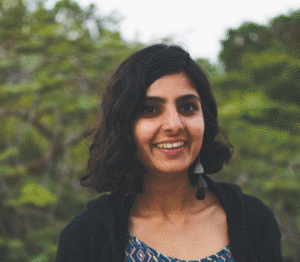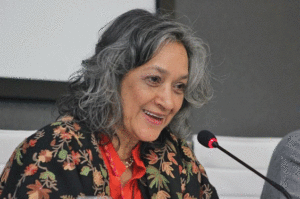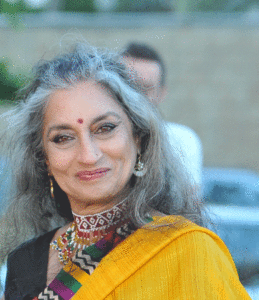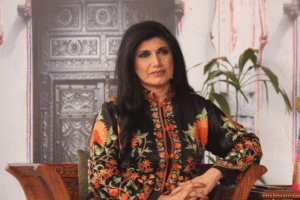How can the younger and senior generation of activists bridge the divide within the Women’s Movement and effect real change?
By Newsline Admin | Opinion | Published 6 years ago
Sadia Khatri is a writer, and the feminist co-founder of collective, Girls at Dhabas.
 We need to listen to each other better, all of us. And accept that as times change, so will our strategies, our sites of resistance, and our languages. I think the generational differences are primarily questions of differing methods, and ideas of what is ‘more’ pressing within feminist politics. It is a simple result of living through different times, of fighting power in its changing manifestations, and using different mediums as our sites of protest.
We need to listen to each other better, all of us. And accept that as times change, so will our strategies, our sites of resistance, and our languages. I think the generational differences are primarily questions of differing methods, and ideas of what is ‘more’ pressing within feminist politics. It is a simple result of living through different times, of fighting power in its changing manifestations, and using different mediums as our sites of protest.
The founding members of WAF took to the streets at a time when there was no social media, when public spaces were legitimate grounds to effect change. Today, because of surveillance and the rise in forced disappearances, the role of public spaces in activism is changing, while the use of social media is increasing. Older feminists need to accept that for us, Facebook and Instagram and Twitter are every bit as political as the Press Club, because they are deeply interwoven with our lives and communities. There has been a fundamental shift regarding how and where we conduct our activism, and what it is that we are demanding.
As we see with #MeToo, it’s not so much about policy as changing norms, and creating space for survivors to speak up, regardless of whether action is taken. Instead of telling us that this is damaging the movement, and that we need to shift attention to policy, older feminists could reflect on what this reveals about the limitations of existing systems. The same goes for other issues, like pleasure politics, often seen as frivolous by the older generation. When Girls at Dhabas took off in Pakistan, several older women’s rights activists dismissed it because they felt there was nothing radical about a bunch of elite/upper middle class girls riding cycles and sitting at dhabas. Compared to the powers they were up against (a military state under Zia), perhaps it isn’t. Yet G@D has found a lot of resonance with women in Pakistan. And I think it is important for the older generation to try and understand why.
It goes both ways of course. Younger feminists are often ignorant of the herstory that’s brought us here: how did the women’s movement start in Pakistan and South Asia, what battles were fought, what can we learn from their successes and failures? We also tend to be suspicious of legal systems and policy-based activism, which is understandable, because they repeatedly fail us. Yet, it would be unfortunate if we did not continue the work of improving laws and policies, because older feminists have fought all their lives to bring it here. And because they are important! I think we need to figure out how to take all the different methods along, and understand that there isn’t a hierarchy of strategy or issue.
I also think that younger feminists need to sit down with the older ones and really learn from their lives and experiences. I just wish there were more of them who were open to guiding us along, rather than writing us off.
Farida Shaheed is a sociologist, a feminist human rights activist and the Executive Director of Shirkat Gah.
 Bridging the generational gap is a perennial challenge for all movements everywhere, curiously posed as one between oldies and youngsters, forgetting the multiple generations in between, who are well positioned to play a bridging role.
Bridging the generational gap is a perennial challenge for all movements everywhere, curiously posed as one between oldies and youngsters, forgetting the multiple generations in between, who are well positioned to play a bridging role.
A few things to bear in mind to bridge these gaps: (1) At the end of the day movements consist of individuals even when they act as a group and movements need maximum numbers to be effective. (2) What sustains movements is the spirit and the fight, not necessarily organisations; just like people, organisations live and die. (3) Sustainability necessitates new initiatives and activists for continuity.
Older activists must recognise that the stranglehold of older activists can only spell the death of the movement; that sustaining the movement means change and new, different ways of fighting for the cause. The seniors should make space for and embrace the new ideas of younger activists. Younger activists should understand that once an activist, it is near-impossible to stop being one because this seems tantamount to giving up the fight, especially when issues of gender inequality in Pakistan continue to be so dire. Also, that older women did not become activists intending to be leaders but in response to circumstances demanding urgent action.
How to bridge the gap(s) is complicated but we must start with putting aside mistrust and whatever other feelings there may be, and proactively create the time and spaces for face-to-face discussions. It is vital to remember that in the end, movements are about effective networking around a shared vision. This means sharing the burden, incorporating and leveraging all our differences to strengthen our movement. The fight is huge: we cannot afford to lose precious resources whether of the young and old or in-between.
Movements need multiple strategies led by multiple faces to be effective. Such spaces would allow us to clarify values and principles and strategise on how best to combine diverse modalities and styles around our common aim. Those with the greatest talent for specific engagements should be allowed to get on with it, and collaboration should not be confused with authority positions. Finally it is critical that we all cut each other some slack. Crucially, however, everyone should be able to express themselves without eliciting snide remarks on social media and elsewhere. There will always be differences, even intense ones, but creative tensions are precisely what energise movements.
Rafia Zakaria is a columnist for Dawn and regular contributor to CNN Opinion. She also authored The Upstairs Wife: An Intimate History of Pakistan and Veil.
 Undoubtedly, the lives of Pakistani women are suspended at the cusp of a moment of change. Urbanisation has inverted the rural-urban divide such that a majority of Pakistani women now live in cities. This, in turn, means that they are amassing economic power and hence becoming able to demand safe spaces at work, at home and everywhere else. Social media has spread awareness of crimes against women and given women a tool via which they can break down the myth that suffering women are alone in their misery.
Undoubtedly, the lives of Pakistani women are suspended at the cusp of a moment of change. Urbanisation has inverted the rural-urban divide such that a majority of Pakistani women now live in cities. This, in turn, means that they are amassing economic power and hence becoming able to demand safe spaces at work, at home and everywhere else. Social media has spread awareness of crimes against women and given women a tool via which they can break down the myth that suffering women are alone in their misery.
It is inevitable that this will cause a rift between an older generation of activists from the pre-social media age, women who learned and practiced their activism through other means than the platforms provided by Twitter and Facebook etc. The key to healing the divide and hence multiplying the strength of Pakistan’s nascent new women’s movement is for young and old activists to understand that both are correct in their approaches. The fact that the older generation of activists used different tools than the ones we do today, should not detract from the truth that the struggle against patriarchy is urgent and that we are all united by the same cause.
The biggest challenge faced by any women’s movement is the dismal spectre of there being no movement at all. Pakistan’s ‘new’ woman’s movement has the capability to take the victories won by the activists of the past, victories that have resulted in the passage of laws against sexual harassment and honour killings, and enable the cultural transformations that will allow for the enforcement of these laws. Change is already happening. The worldwide #MeToo movement has catalysed conversations in Pakistan that were unimaginable even one decade ago. It is crucial and urgent that we continue these conversations without being bogged down by generational differences.
As someone who belongs to the newer generation of activists, I can attest to the deep respect I hold in my heart for the women who came before me, women like the late Asma Jehangir, Hina Jillani, Ayesha Jalal, Sherry Rehman, Maleeha Lodhi and so many more. No Pakistani feminist today could exist or agitate without the foundations that have been laid by these women and those before them. The path forward has to be one that we forge together. Change is coming, but Pakistani women must refuse to be bogged down by the differences in the details and keep their eye on the glorious goal of claiming Pakistan for its women rather than only for its men.
Sheema Kermani is a classical dancer, a prominent theatre practitioner and a women’s rights activist.
 I personally have never found a divide between myself and the younger generation of activists. In fact, with due respect to the senior activists, I would perhaps say that I identify more with the young feminists of today. When I became a conscious feminist (well over 40 years ago) my concerns and my demands were that “My body is my own – no one owns my mind or my body; I will make my own decisions about having children or not having children; my partner and I will share equally in the household chores” etc. These are some of the kind of demands that the younger generation of feminists have today, and how can I not consider myself with them?
I personally have never found a divide between myself and the younger generation of activists. In fact, with due respect to the senior activists, I would perhaps say that I identify more with the young feminists of today. When I became a conscious feminist (well over 40 years ago) my concerns and my demands were that “My body is my own – no one owns my mind or my body; I will make my own decisions about having children or not having children; my partner and I will share equally in the household chores” etc. These are some of the kind of demands that the younger generation of feminists have today, and how can I not consider myself with them?
I take pride in calling myself a feminist and I believe in my right to sexual freedom, to personal decisions, while on the other hand many senior generation activists would withhold their agreement to these rights and say, “We do not believe in sexual freedom for the female population!” The question is, why should this discrimination continue? The older activists need to review their ideas and reflect deeply about why this divide persists.
Perhaps the divide is not between the younger and senior generation but between the conservative and the free-thinking people. Perhaps it is not about age at all, but about the worldview that we hold. When I read the feminists and the revolutionary activists of the 1917 revolution of the Soviet Union, I found that they were at that point discussing revolutionary ideas about equality between the sexes in all forms — sexual, social, cultural and economic. Yes, they did not manage to achieve these aims and I believe that this was the biggest failing of all the socialist revolutions that have taken place in the world. This failure was due to the fact that social values and human relationships did not change even after the revolution – frankly speaking, these are cultural changes and need to take place through cultural means. Consequently, I moved on to become a cultural practitioner and a cultural interventionist because I believe that this is the way to bridging the divide for an effective change.
I passionately believe that if we women understand and realise our true potential as independent persons and insist on contributing in all spheres – politics, art, business, technology as well as family life – civilisation might be led towards maturity instead of annihilation.
Both senior as well as young women’s rights activists need to stand together, irrespective of minor differences. Our fight is not between ourselves – it is against the conventional moralist. We need to recognise the enemy. We must inspire and incite all women with any pride, imagination and sense of moral responsibility, any man with a conscience, to join hands to achieve a just and humane society, where women do not face violence and oppression. This can only be done if the old and the young, all of us unite and stand together!
I believe bridging the divide is possible and proof lies in the fact that last year at the Aurat March which we organised to celebrate International Women’s Day, women of all ages and backgrounds came together to march for their rights – and so it can and will happen again this year on March 8, at Aurat March. We will bridge the divide!
Dr Fouzia Saeed is a women’s rights activist, and the author of Taboo, Working with Sharks and Forgotten Faces.
 The younger generation needs to broaden its perception of the women’s movement. I have noticed that most younger people think of women’s movements simply as the activation of a few women’s organisations, who publicise their work more, are heavily donor-funded and conduct most of their programmes in English. Also, there is a perception that these women are constantly fighting with each other. This is a very narrow perception. We do not have to think of this small component of the movement as the core leaders or representative of the movement. The sweep of the women’s movement has been broad, in both urban and rural areas, has amazing segments and can boast of many successful movements within it. The senior generation needs to document their own work and experiences and pass them on to the younger generation so they can take pride in those achievements and take them forward.
The younger generation needs to broaden its perception of the women’s movement. I have noticed that most younger people think of women’s movements simply as the activation of a few women’s organisations, who publicise their work more, are heavily donor-funded and conduct most of their programmes in English. Also, there is a perception that these women are constantly fighting with each other. This is a very narrow perception. We do not have to think of this small component of the movement as the core leaders or representative of the movement. The sweep of the women’s movement has been broad, in both urban and rural areas, has amazing segments and can boast of many successful movements within it. The senior generation needs to document their own work and experiences and pass them on to the younger generation so they can take pride in those achievements and take them forward.
The best initiatives are those where the younger and senior generation of activists are both working together for a cause – that is how continuity is maintained.
South Asia is rich in activism, which to me is more of a volunteer role that we play. The trend of paid jobs for social change-makers, which began in the 1990s, changed the scenario and those who were not the real leaders of the people became the “leaders” because of the terms of reference (TOR) of their jobs. I think that is where the perception of the women’s movement started to change. But the real leaders and the ‘paid’ leaders both can be found in the larger women’s movement. The important thing is to recognise that our movement is very broad. The younger women’s rights activists should not get turned off by those few who create the limelight but seek out the struggles of women who are not quite visible.
In order to reduce gaps or bridge any divide, the younger generation must:
Learn about the history of the women’s movements through reading, talking to the senior activists and learning from every source possible.
Reclaim and celebrate what women have achieved so far and connect with that process.
Consciously break the stereotypes of women’s rights activists that the media constantly promotes to undermine their work.
Believe in themselves and move ahead with full confidence.
The senior generation on the other hand, should be more inclusive, understanding and open to listening to the issues and challenges faced by the younger generation. It should speak in the local languages and be less judgmental.


